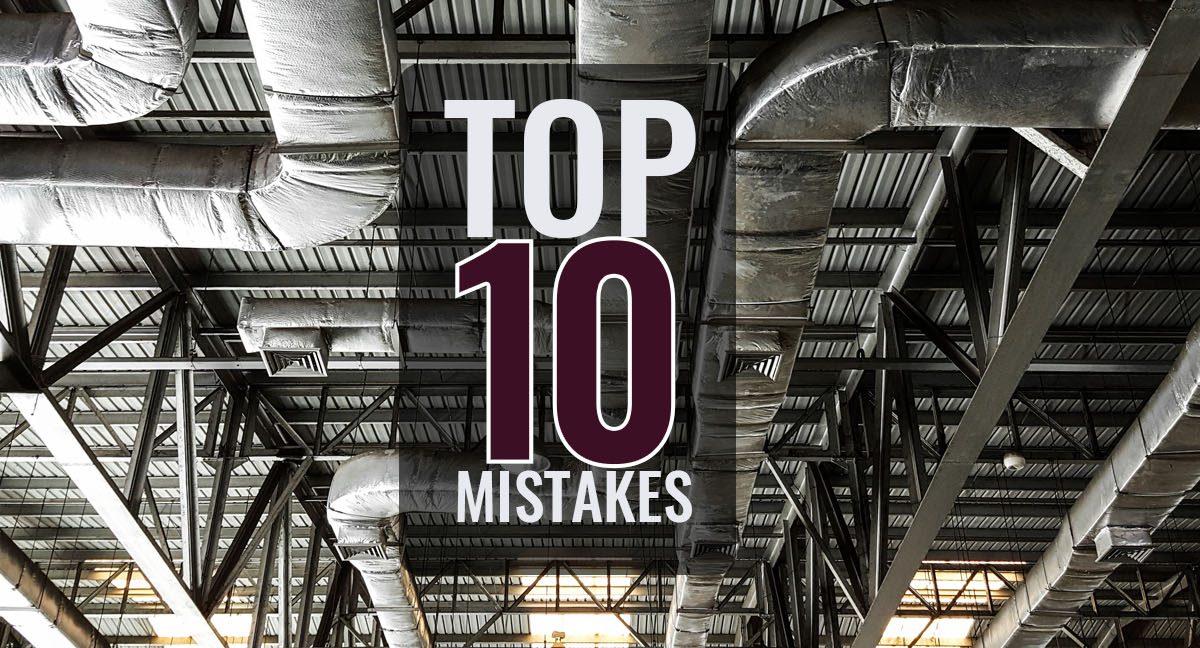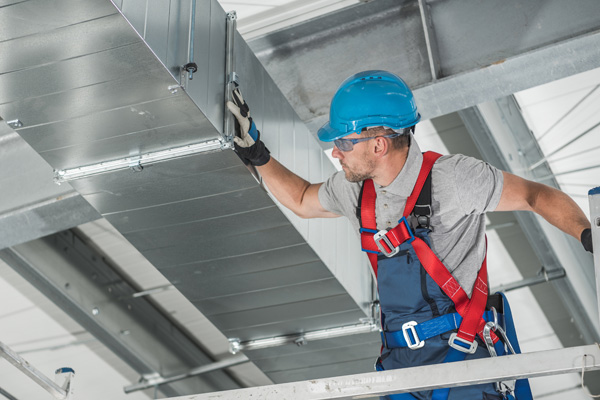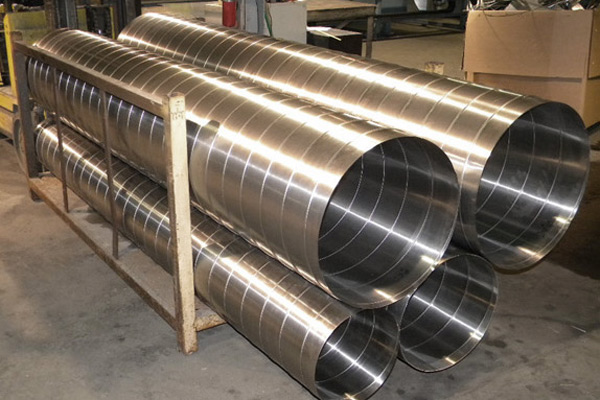The Top Ten Common Mistakes Made by Commercial HVAC Contractors
When HVAC contractors make mistakes, they can -and usually do- cost the company, as well as the customer valuable time and money.
In this issue, we discuss common mistakes that impact not only the performance of the HVAC systems that you install, but the soundness of your operation and your reputation.
Number 10:
Ignoring opportunities to help customers improve building efficiency.
As an HVAC contractor, you have access to much, if not all of the inner workings of the building in which installations are being performed.
Not addressing issues that could be discovered during an install, such as:
- Poorly or even un-insulated areas
- Airflow issues (excessive or inadequate)
- Lack of air sealing
Discovering and informing your customers of such issues, even if you do not offer services to remedy them, can and will improve the overall quality of the job.
Number 9:
Ignoring the ventilation aspect of HVAC.
Many companies simply install a system to heat or cool a building without giving much consideration at all to the ventilation needs of the specific job.
Environmental regulations and energy codes for many structures are resulting in the construction of buildings that are more airtight than ever, making planning an adequate ventilation system a must.
Number 8:
Failure to keep up with industry standards.
Like any industry, HVAC must change and adapt as new technology, regulations, and codes change how physical systems are planned and installed. Zone by zone heating and cooling controls are one example.
Failing to keep up with the latest standards in efficiency and regulation will surely result in loss of business as customers look to companies that stay on the cutting edge.
Number 7:
Trying to be the lowest bidder.
More detrimental than most, the cost-cutting involved in providing the “lowest quote” to attempt to get a job can often undercut your company in the long run.
Forced cost cutting for the sake of guaranteeing that you get the job is likely going to lead to making many of the mistakes mentioned in this list.
Using inexperienced labor, not putting enough time into planning and calculating, and using sub-standard equipment will lead to poor finished product and displeased customers.
Number 6:
Ignoring the science of airflow.
All too often, equipment is installed on “rules of thumb” and standards that are focused on saving time and money (for the contractor).
The reality of the situation is, however, that no two buildings are alike… failure to ensure proper duct placement, register placement, and duct sizing can result in an inefficient system that in the end is going to cost your customer more money than it should.
Number 5:
Not doing the math.
Failing to perform proper calculations when it comes to planning an install is a surefire way to provide sub-par results to your customer.
Companies that continue to perform work the way it was done 30 years ago are not doing themselves and their customers any favors. As HVAC technology changes, the need to master the math involved in determining the appropriate duct and central unit sizing/placement has become imperative.
Number 4:
Failing to consider the building a system as a whole.
Any HVAC contractor that does not consider the whole building as a functioning system, in which HVAC equipment is but a single element, is not doing all that they can to serve the customer.
In-depth analysis of the building as well as thoroughly discussing the customer’s needs can allow you to consider things such as:
- Increasing airflow to an area where servers or other heat-generating equipment is going to be installed.
- Ensuring that air intakes are not going to be in an area where potentially unpleasant odors or potentially dangerous gasses could occur.
- Planning a system in a way that allows easy modification in the event of potential changes to the other building systems.
Number 3:
Lacking proper understanding/willingness to ensure combustion safety
Let’s face it, burning anything inside a building is inherently dangerous, especially when Carbon Monoxide is a significant by-product of the fuel in use. Even a waste paper basket fire can be a problem in a well-sealed building.
Considering the fact that many newer buildings are significantly more air-tight than older buildings as we mentioned in Number 9: the design of ventilation systems must be adapted in order to prevent the accidental ingress of carbon monoxide into occupied spaces.
Preventing excessive negative pressure in an area of a central heating unit is an absolute imperative to ensure the safety of people in the building.
Number 2:
Performing in-house estimating.
Quite often, when a smaller HVAC company offers their own estimating services, problems can arise in terms of turnover time as well as quality of work.
Today, estimating is a complex effort involving state-of-the-art software that is far from simple to master. Hiring a company experienced in professional HVAC estimating can save your business and your customers’ money, adding profit directly to your bottom line.
Number 1:
Performing in-house duct fabrication.
HVAC contractors have traditionally had their own in-house fabrication shops to manufacture the ductwork they install. This practice has worked for contractors in the past to ensure quality, control production directly, and assure timely delivery.
In the recent years, however, this traditional system has become problematic for many HVAC contractors.
Reasons for this system becoming problematic include:
- Skilled, qualified labor is becoming increasingly difficult to find.
- Lack of purchasing power in materials procurement means higher cost for a small company.
- Maintaining equipment and inventory requires its own infrastructure.
- When the economy dips, keeping individual in-house shops busy is a challenge.
- Some contractors have marketed their shops for outsourced projects, only to find other contractors prefer purchasing products from a supplier, not the competition!
- Contractors realize their core competency is installation, not manufacturing.
- In-house manufacturing becomes an inefficient profit sink, a maze of materials procurement problems, labor problems, inventory problems, and project management problems.
Let The Cincinnatus Group Be Your HVAC Partner!
Did you know TCG offers services in shop and duct drawings as well?
Our team of experienced, high-tech draftsman take you from design, to fabrication and installation more efficiently than ever before.
Combining old-school knowledge with state-of-the-art design systems allows us to:
- Deliver reliable shop drawings up to 50% faster
- Reduce errors to historic lows while meeting the most demanding specifications
- Deliver accurate data directly to your fabrication facility or ours
- Assure that each duct section is precision fit to its location, connections, and support
The goal we’ve achieved is a simple one – superior shop drawings developed more cost-effectively than ever before. Visit our pages on Duct Drawings and Automating HVAC Production to learn more.
Success in Our Business is About Service.
Success in our business is about service. The quality of our HVAC duct work is of the highest caliber and our price competitive with the best in the industry. Nonetheless, quality and price are default items today in sheet metal fabrication. They give us access to the playing field. Service is where The Cincinnatus Group. gains its edge, and service means people – it’s about our experienced personnel and the relationships we build with each and every customer.
Duct Fabrication is TCG’s Business
At TCG Duct, we can provide all or part of your HVAC fabrication needs. Your project is priced from a Material List or via a take off from prints you provide. Our team of engineers, fabricators and technicians are trained on the latest equipment and methods that enable us to meet your exacting standards.
Let TCG Duct be your partner in the HVAC Industry as an experienced, high-quality manufacturer of HVAC duct of all types. Our goal is to partner with our customers in ways that make the entire workflow from order to installation a seamless exercise in time and cost savings.
The Cincinnatus Group supplies traditional Rectangular Ductwork as well as Spiral Ductwork, Double Wall Spiral Duct , PCD Ductwork, and Industrial Welded Ductwork.
Why Choose The Cincinnatus Group?
As your partner, The Cincinnatus Group helps your organization stand out in its marketplace, win more bids, save substantial costs, and build the knowledge and skills your team needs to continually meet new challenges effectively and profitably.
Our strong work ethic, accountability, and pursuit of excellence sets us apart from other contracted sales and marketing services, and our unique expertise and proprietary ductwork systems make us unique amongst our competitors.
At The Cincinnatus Group, our fabrication partners gain access to our unique experience and expertise in contracted sales and marketing.
Our assets help you navigate the ever-changing markets of the 21st century.
To learn more about our Contracted Sales services or other services we provide: Contracted Estimating and Take Offs, CAD/BIM/Coordination Drawings, and Project Management Assistance, please call The Cincinnatus Group at 878-295-8009, or visit our Contact Us page today. We are looking forward to the opportunity to help grow your business.






